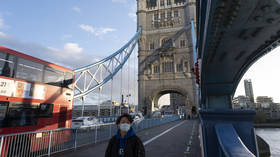Five reasons why England's new coronavirus lockdown is not justified

There’s a grave danger that Boris Johnson’s decision to shut down the country again is based on a flawed, one-eyed interpretation of the facts, and that the ‘cure’ will be worse than the disease, again. Have we learned nothing?
On Saturday night, British prime minister Boris Johnson confirmed the worst-kept secret of the moment: that England would be going back into lockdown from Thursday 5 November - Bonfire Night. But the only things going up in smoke will be some of our most basic freedoms - and it’s far from clear that such a clampdown is justified.
This was a moment that Johnson would have preferred to avoid, having made clear just a couple of weeks ago that he thought the idea of another lockdown was the “height of absurdity”. Yet it would appear that he has been persuaded that “there is no alternative”, echoing a phrase made famous by Margaret Thatcher. He said that “the virus is spreading even faster than the reasonable worst case scenario of our scientific advisers, whose models... now suggest that unless we act we could see deaths in this country running at several thousand a day, a peak of mortality alas far bigger than the one we saw in April.”
Also on rt.com Lockdown till a Covid vaccine comes? It’s too long to wait, and there’s no guarantee it will be effective anywayBut do the facts really justify this damaging new shut down of the country’s economy, or is Johnson basing his decisions on the same advice from the same advisers who, frankly, got it wrong last time? Let’s take a sober assessment of the evidence.
1. Cases are not surging
In his summary of the evidence, the chief scientific adviser, Sir Patrick Vallance, provided a wide range of estimates for the daily incidence of Covid-19 in England, suggesting it could be anything from 38,500 to 105,000, based on three different sources. The one thing Vallance didn't rely on were the actual results from the government's own testing programme - the figures we've been drip fed daily since this crisis began, which suggest just over 18,000 cases per day. But assuming that other sources are more accurate, given the problems with that testing programme, very roughly one percent of the population is currently infected with Covid-19.
According to government estimates, approved by the Scientific Advisory Group on Emergencies (SAGE), the number of cases has been rising by between 2% and 4% per day. The now magical 'R' number has fallen to between 1.1 and 1.3 - in other words, 10 infected people are on average infecting between 11 and 13 other people. Far from cases surging, they appear to be rising either quite slowly now or hitting a plateau.
Another source that appears to confirm the approximate number of cases and the slow rate of growth is the Covid-19 Symptoms Study project run by King's College London and medical data firm Zoe, where over a million users per day input their current state of health into a smartphone app. The project's latest research update also says that case numbers “are not surging”. The data suggests that “the doubling rate for cases is currently 28 days”. The project leader, Professor Tim Spector, adds: “Data on Covid-19 can be confusing for the public and we can't rely simply on confirmed cases or daily deaths, without putting them into context. Hospital admissions are rising as expected, but deaths are still average for the season.”
2. Forecasting is hard - but these ones are absurd
Given that the actual data doesn't look that scary, Vallance switched to talking about models. All of these ‘winter scenarios’, assuming that there are ‘no changes in policy or behaviour’, suggested we could expect far higher numbers of deaths. One model, produced by Public Health England and Cambridge University, attracted particular attention because it suggested that up to 4,000 people could be dying each day by mid-December if action were not taken.
But as has been revealed since the news conference, the results from the most alarming models are three weeks old (produced even before the new tier system of restrictions was introduced) and were predicting that by now we would be seeing as many as 1,000 deaths per day. In fact, the highest recent seven-day average figure for daily deaths was 219 in the week up to 30 October. That figure may get revised upwards a little, but clearly the figures from this model are absurd. Even the modelled figures from other sources seem to show double the number of actual deaths.
Also on rt.com Stop smoking, ditch the pyjamas, stay at your desk: how ‘bossware’ technology is secretly monitoring you working at home3. It may not all be Covid-19
Even the reported number of deaths is open to question. It is still not clear if all of these people died because of Covid-19, or simply had a positive test result, but actually died from something else. Certainly, the vast majority of people dying are old and have other serious medical problems like dementia or heart disease.
But what could the ‘something else’ be that could be mistaken for Covid? What is striking, as reported by RT last week, is the disappearance of influenza. Flu cases have dropped by 98% in the UK and disappeared almost completely in the southern hemisphere winter. It seems at least possible that some of the deaths attributed to Covid-19 were in fact false positives and were actually caused by influenza. This question could be resolved by case reviews of Covid-19 deaths with confirmatory tests. If even a small proportion of deaths attributed to coronavirus were due to something else, it could cast a different light on the likely trajectory of the pandemic.
4. Hospitals are not in danger of being overwhelmed
The mantra throughout the crisis in the UK has been ‘Protect the NHS’. It is obviously wise to ensure that we don't get to the point where there are so many Covid patients that some get left untreated. In northern England, some hospitals do appear to be under serious pressure, but few have reached the peak levels seen in the spring. In the apparent absence of influenza cases, fears of ‘double trouble’ in hospitals - a flu outbreak and Covid epidemic simultaneously - have not transpired.
Might ‘Tier 3’ restrictions, which have only recently been enacted in Manchester, Nottingham and Leeds, have kept hospital cases at manageable levels while allowing a semblance of normal life to continue? We’ll never know because the government has not given them enough time to take effect.
Meanwhile, in many other parts of the country, the number of patients in hospitals is well below the spring peak. For example, in London, there were 921 patients with Covid-19 in hospital on 1 November, compared to 4,813 on 8 April, and the rate of increase looks comparatively gradual. In the Midlands, the growth rate is higher but there were still only 1,764 patients on 1 November compared to 3,101 on 10 April.
Moreover, we have greater capacity to deal with Covid than we did in the spring, when it hit the NHS with little warning, protective equipment and ventilators were running out and there were few treatment options. And that’s even before we mention the barely used Nightingale field hospitals set up around the country, which most commentators agree are very much a last resort for critical care but could be used for ‘step down’ care for patients over the worst of their illness, freeing up hospital beds.
Also on rt.com Making the wearing of face masks compulsory is inconsistent, illogical, illiberal & divisiveSo, even in its own terms of protecting the NHS, the case for a lockdown has not been well made. Infection rates also appear to be falling in hotspots like Liverpool, where they dropped from nearly 0.7% of the population for the week ending 8 October to 0.3% three weeks later. For Manchester, the equivalent figures are 0.53% and 0.39%, while in Nottingham infection rates have plunged from more than 1% to under 0.4%. In the places where hospitals have been busiest, the pressure may have soon started to ease even had lockdown not been implemented.
5. The cure is likely to be worse than the disease (again)
Meanwhile, the damage from another lockdown will be enormous. No assessment of its impact has apparently been done by the government.
Julia: "Has the government carried out an impact assessment" on the cost of lockdown?Robert Jenrick: "You're asking an unreasonable question". https://t.co/QSJp3wD1s9
— Anshul (@Anshul__K) November 3, 2020
But we know that businesses that have struggled to survive will go bankrupt. Social isolation will increase. Suicides will spike again. People who should be going to hospital will put off doing so until it is too late for fear of stretching the NHS too far. That's despite the fact that even routine surgery is still, mostly, going ahead as planned in the busiest hospitals. Johnson was quite right to take a regional approach to restrictions when it is clear that many parts of the country are seeing much lower rates of infection than in the hotspots.
The prime minister seems to have panicked, acting like a driver who has been unable to work out how to control his vehicle and has decided there is no option but to slam into a lamp post to stop it. The only complaint from the official opposition, Labour, has been that the crashing of the car didn't take place three weeks ago. There’s a big danger that decisions are being made in a group-think bubble in Whitehall - we desperately need more critical voices in positions of influence if we are to save our economy, our lives and our freedom.
Think your friends would be interested? Share this story!
The statements, views and opinions expressed in this column are solely those of the author and do not necessarily represent those of RT.














